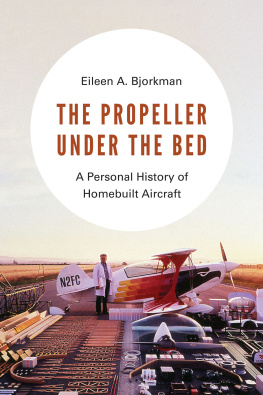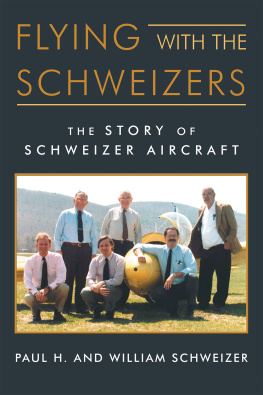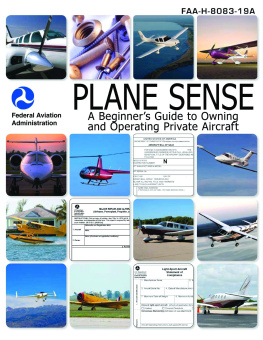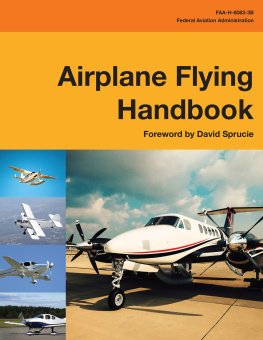
THE PROPELLER UNDER THE BED
Eileen A. Bjorkman
THE PROPELLER UNDER THE BED
A Personal History of Homebuilt Aircraft
UNIVERSITY OF WASHINGTON PRESS
Seattle and London
Copyright 2017 by the University of Washington Press
Printed and bound in the United States of America
21 20 19 18 17 5 4 3 2 1
All rights reserved. No part of this publication may be reproduced or transmitted in any form or by any means, electronic or mechanical, including photocopy, recording, or any information storage or retrieval system, without permission in writing from the publisher.
University of Washington Press
www.washington.edu/uwpress
Library of Congress Cataloging-in-Publication Data
Names: Bjorkman, Eileen A., author.
Title: The propeller under the bed : a personal history of homebuilt aircraft / Eileen A. Bjorkman.
Description: 1st edition. | Seattle : University of Washington Press, [2017] | Includes bibliographical references and index.
Identifiers: LCCN 2016049323 | ISBN 9780295741444 (hardcover : alk. paper)
Subjects: LCSH: Ebneter, Arnold, 1928 | Air pilotsUnited StatesBiography. | Airplanes, Home-built.
Classification: LCC TL540.E335 B56 2017 | DDC 629.13092 [B] dc23
LC record available at https://lccn.loc.gov/2016049323
The paper used in this publication is acid-free and meets the minimum requirements of American National Standard for Information SciencesPermanence of Paper for Printed Library Materials, ANSI Z39.481984.
To my mother
CONTENTS
ACKNOWLEDGMENTS
I THANK MY MOTHER, WHO INSPIRED BOTH THE TITLE AND IDEA for the book, and my father, for enduring dozens of interviews, digging through logbooks, finding old photos, and answering hundreds of questions. I also thank the many people who provided comments on the original manuscript. This book would not have been possible without my editor, Regan Huff, who had the vision to turn a rambling story about my father into a tale of homebuilt aircraft.
John Little at the Museum of Flight Research Center in Seattle, and Susan Lurvey at the Experimental Aircraft Associations Museum Library, gave me invaluable assistance in locating old magazines, letters, and books.
Finally, I must thank my cats, Scout and Butterball, who missed many hours of lap time.
LIST OF ILLUSTRATIONS
THE PROPELLER UNDER THE BED
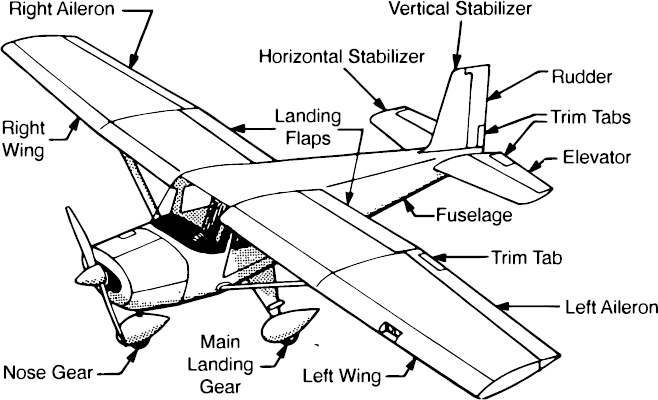
COMPONENTS OF A TYPICAL LIGHTPLANE
The Flight
Every pilot knows the chances he takes at times; thats part of aviation. Ours is not a nation built on too much caution.
Charles Lindbergh, The Spirit of St. Louis, 1953
JULY 25, 2010, EVERETT, WASHINGTON. SMALL AIRPLANES BUZZED overhead and trundled to and from the runways at Paine Field. On a normal weekday, jumbo jets roll off Boeings assembly line, which is housed in the worlds largest building and sits at the south end of the airport. On weekends, airplanes that could fit in a 747s baggage compartment invade the airspace. This particular Sunday was no exception.
On a ramp away from the din, a small crowd surrounded a silver airplane with a jaunty yellow nose. The airplane resembled a miniature World War II fighter resting on its tail, nose poking into the air. The cockpit was built low to the ground, so an observereven a childcould easily peer at the instruments and controls. An aeronautical engineer present might have noticed the long wings that tapered from about four feet in width where it attached to the fuselage to about a foot at the wingtips and deduced that this airplane, like a U-2 spy plane, was built to stay airborne for much longer than the three or four hours that most small planes stayed aloft at a time. A pilot might have spotted the three bathroom scales, one under each wheel, and realized that someone was planning something more than a routine flight.
Casual observers might have marveled at the word EXPERIMENTAL painted on the side of the airplane and wondered if a thin elderly man dressed in a military-green flight suit was a test pilot. That man, Arnold Ebneter, was my father; and as he wandered about the plane, he checked for anything that might make his upcoming flight end sooner than the planned eighteen hours. He had conceived the airplane as a college design project and, after fifty years of persistence and procrastination, had birthed the machine in his garage and then coaxed it into its final configuration. Today, he was confident he could fly it nonstop for 2,328 miles to set a new world record for the greatest number of continuous miles flown in an airplane weighing less than 500 kilograms, or 1,102 pounds.
After satisfying himself that every nut and rivet was in place, Arnold called for a fuel truck and climbed into the cockpit. He carried only the barest of essentials for the flighttwo energy bars, a quart of water, and a picture of my late mother, Colleen. When the fuel truck arrived, he asked the driver to fill the seven tanksthree in each wing and one in the cockpit. Helpers on the ground called out weights on the individual scales, which Arnold added for the total weight, all under the watch of an observer from the National Aeronautic Association, keeper of US aviation records. When the combination of airplane, supplies, fuel, and Arnold weighed a few ounces shy of 1,102 pounds, he told the fueler to stop.
Record-breaking aircraft come in all sizes and shapesthey are balloons, airplanes, helicopters, and gliders, to name just a few. Except for absolute records, pilots compete in aircraft type and weight classes, and nearly four hundred types of records exist for airplanes, in a dizzying array of categories, including altitude, speed, time-to-climb, duration, efficiency, payload, and distance. For record-setting purposes, balloons are Class A, airships are Class B, powered airplanes are Class C, gliders are Class D, and so on. Airplanes are further divided into C-1 for landplanes, C-2 for seaplanes, and C-3 for amphibians, and these three categories are again divided by takeoff weight, such as a/o for less than 300 kilograms, a for 300500 kilograms, and b for 5001,000 kilograms. The final classification is by powerplant, with Group 1 (or I) being an internal combustion engine, Group 2 a turboprop, and so on.
My fathers airplane fell into the C-1aI class, and his coveted prize was a straight line distancethe shortest route between takeoff and landing points; pilots can also set records for closed circuits by flying multiple times around two or more points on the ground. Seven pilots, before my father attempted it, had progressively increased the C-1aI straightline distance record, beginning in 1950 with Belgian Albert Van Cotthem in a factory-built aircraft, who flew a pedestrian 587 statute miles, a distance easily achieved by many light airplanes with a strong tailwind. The record fell three times over the next five years, all in factory-built aircraft. But in 1957, a Finnish homebuilt airplane seized the record with a 1,767-mile flight, and homebuilts have monopolized the category since. In 2010, the record of 2,214 miles for a C-1aI aircraft set in 1984 had not yet been broken, despite the fact that twenty-six years was an eternity in the world of airplane records, many of which have lives measured in months or single-digit years rather than decades.
Unlike when pilots attempted record-setting flights during the first half of the twentieth century, there were no adoring media to record my fathers 2010 attempt nor any cash prizes at stake. Instead, a handful of friends and family were at the airport to see him off. His reward would be the fulfillment of his dream of proving to himself that he could design and build a record-setting airplanealthough six military moves, countless deployments, the Vietnam War, kids in college, and an addiction to flying that diverted his attention and spare cash from airplane building had all conspired to thwart his record attempt until he was eighty-two years old.
Next page
